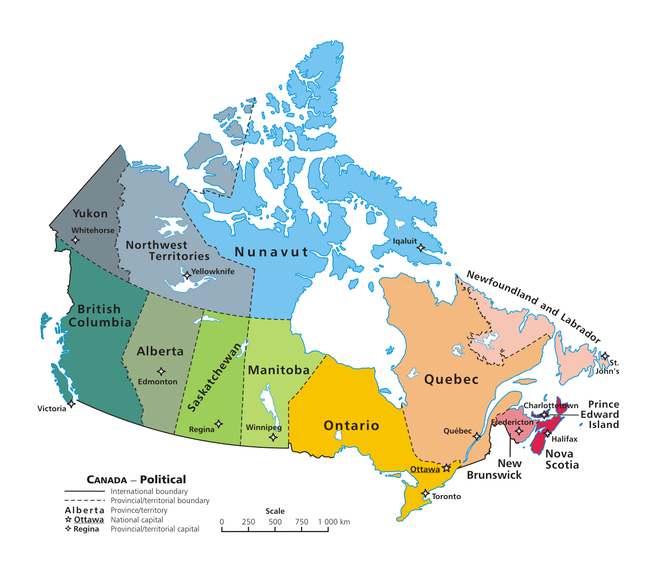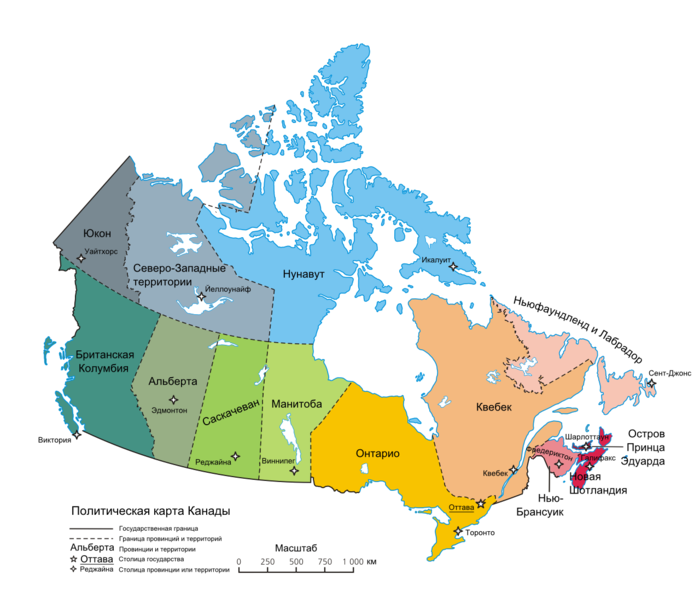
|
Столиця |
Оттава |
|
||
|---|---|---|---|---|---|
|
Найбільше місто |
Торонто |
|
||
|
Офіційні мови |
англійська мова, французька мова |
|
||
|
Державний устрій |
Конституційна монархія |
|
||
|
Монарх |
Єлизавета II (королева Великобританії) |
|
||
|
Генерал-губернатор |
Девід Ллойд Джонстон |
|
||
|
Прем'єр-міністр |
Стівен Гарпер |
|
||
|
Незалежність |
Канадська конфедерація |
|
||
|
Британський північноамериканський акт |
1 липня 1867 |
|
||
|
Канадський акт |
7 квітня 1982 |
|
||
|
Площа |
|
|||
|
Загалом |
9984670 км² |
|
||
|
Води (%) |
8,92 |
|
||
|
Населення |
|
|||
|
оцінка 2007 р. |
32623340 |
|
||
|
перепис 2006 р. |
31612897 |
|
||
|
Густота |
32/км² |
|
||
|
ВВП (ПКС) |
2009 р., оцінка |
|
||
|
Повний |
$1280 мільярдів |
|
||
|
На душу населення |
$39033 |
|
||
|
|
||||
|
|||||
|
|||||
|
|||||
|
|||||
|
|||||
|
|||||
|
|||||
|
|||||
|
|||||
|
|||||
|
|||||
|
|||||
|
|||||
|
|||||
|
|||||
|
|||||
|
|||||
|
|||||
|
|||||
|
|||||
Capital |
Ottawa |
Largest city |
Toronto |
Official language(s) |
English and French |
Government |
Federal parliamentary democracy and constitutional monarchy |
Monarch |
Elizabeth II |
Governor General |
David Johnston |
Prime Minister |
Stephen Harper |
Establishment |
|
British North America Acts |
July 1, 1867 |
Statute of Westminster |
December 11, 1931 |
Canada Act |
April 17, 1982 |
Area |
|
Total |
9,984,670 km2 (2nd) 3,854,085 sq mi |
Water (%) |
8.92 (891,163 km2/344,080 mi2) |
Population |
|
2011 estimate |
34,467,000 (36th) |
2006 census |
32,623,490 |
Density |
3.41/km2 (228th) 8.3/sq mi |
GDP (PPP) |
2010 estimate |
Total |
$1.330 trillion |
Per capita |
$39,057 |
Канада займає більшу частину півночі Північної Америки. Вона має загальний сухопутний кордон з США на півдні і на північному заході (між Аляскою і Юконом) і протягнулася від Атлантичного океану на сході до Тихого на заході і Північного Льодовитого на півночі. Вона також має морську межу з Францією (острови Сен-П'єр і Мікелон) і Данією (острів Гренландія). Найпівнічніше поселення в Канаді та у світі – Алерте, база збройних сил Канади на північному краю острова Елсмір. Канада – друга за розміром країна світу.
Щільність населення, близько 3,5 чоловік на км², є однією з найнижчих в світі. Найбільш населена область країни — коридор Квебек - Віндзор уздовж рівнинних берегів річки Святого Лаврентія і на південному сході Великих озер.
Канада — конституційна монархія. Глава держави — король або королева Великої Британії; зараз це Єлізавета Друга, яка має титул королеви Канади і яку в країні представляє генерал-губернатор Канади. Кандидатів на цю чотирьохрічну посаду призначає діючий прем'єр-міністр і затверджує королева.
Конституція Канади — правова основа країни і складається, як із записаного тексту, так і неписаних традицій та угод. У Конституції вміщено і Канадську Хартію Прав і Свобод, яка гарантує громадянам основні права і свободи. У Канаді під конституцією розуміється зведення актів, британських законів, судових рішень тощо. Двома основними документами вважаються Акт про Британську Північну Америку 1867 року, що проголосив Канаду домініоном Великобританії, і акт 1982 року, що встановив, Canada is a North American country consisting of ten provinces and three territories. Located in the northern part of the continent, it extends from the Atlantic Ocean in the east to the Pacific Ocean in the west and northward into the Arctic Ocean. It is the world's second largest country by total area. Canada's common border with the United States to the south and northwest is the longest in the world.
Canada occupies a major northern portion of North America, sharing the land borders with the contiguous United States to the south and the U.S. state of Alaska to the northwest, stretching from the Atlantic Ocean in the east to the Pacific Ocean in the west; to the north lies the Arctic Ocean.
The population density, 3.3 inhabitants per square kilometer (8.5 /sq mi), is among the lowest in the world. The most densely populated part of the country is the Quebec City – Windsor Corridor, (situated in Southern Quebec and Southern Ontario) along the Great Lakes and the Saint Lawrence River in the southeast.
Canada has strong democratic traditions upheld through a parliamentary government within the construct of constitutional monarchy; the monarchy of Canada is the foundation of the executive, legislative, and judicial branches. The sovereign is Queen Elizabeth II, who also serves as head of state of 15 other Commonwealth countries and each of Canada's ten provinces and resides predominantly in the United Kingdom. As such, the Queen's representative, the Governor General of Canada (presently David Lloyd Johnston), carries out most of the federal royal duties in Canada.
The direct participation of the royal and viceroyal figures in any of these areas of governance is limited, though; in practice, their use of the executive powers is directed by the Cabinet, a committee of ministers of the Crown responsible to the elected House of Commons and chosen and headed by the Prime Minister of Canada
що всі закони, що приймаються в Канаді, не потребують формального підтвердження у парламенті Великої Британії.
У країні діє парламентська система демократії з федеральною системою парламентського уряду. Прем'єр-міністр Канади — глава уряду. За традицією це лідер політичної партії, яка отримує більшість у Палаті Громад парламенту. Прем'єр-міністр формує кабінет міністрів, який формально призначається генерал-губернатором Канади. Кабінет Міністрів має складатися з депутатів Палати Громад; традиційно до нього входять члени партії прем'єр-міністра. Виконавча влада в країні належить прем'єр-міністру і Кабінету; міністри перед вступом на посаду складають присягу вірності Королеві, щоб формально стати королівськими міністрами. Діючий прем'єр-міністр Канади з 6 лютого, 2006 р.— Стівен Гарпер, лідер Консервативної партії Канади.
(presently Stephen Harper), the head of government. To ensure the stability of government, the governor general will usually appoint as prime minister the person who is the current leader of the political party that can obtain the confidence of a plurality in the House of Commons. The Prime Minister's Office (PMO) is thus one of the most powerful institutions in government, initiating most legislation for parliamentary approval and selecting for appointment by the Crown, besides the aforementioned, the governor general, lieutenant governors, senators, federal court judges, and heads of Crown corporations and government agencies. The leader of the party with the second-most seats usually becomes the Leader of Her Majesty's Loyal Opposition (presently Jack Layton) and is part of an adversarial parliamentary system intended to keep the government in check.
Canada's federal structure divides government responsibilities between the federal government and the ten provinces. Provincial legislatures are unicameral and operate in parliamentary fashion similar to the House of Commons.[105]Canada's three territories also have legislatures, but these are not sovereign and have fewer constitutional responsibilities than the provinces and with some structural differences
Административное деление
На данный момент Канада разделена на 10 провинций и 3 территории. Самой новой административной единицей Канады является территория Нунавут (создана в 1999).
Административное деление Канады |
|
|
|
|
|
Провинции (1)
|
Территории (1)
|
|
Canada is a federation composed of ten provinces and three territories. In turn, these may be grouped into regions: Western Canada, Central Canada, Atlantic Canada, and Northern Canada (Eastern Canada refers to Central Canada and Atlantic Canada together). Provinces have more autonomy than territories. The provinces are responsible for most of Canada's social programs (such as health care, education, and welfare) and together collect more revenue than the federal government, an almost unique structure among federations in the world. Using its spending powers, the federal government can initiate national policies in provincial areas, such as the Canada Health Act; the provinces can opt out of these, but rarely do so in practice. Equalization payments are made by the federal government to ensure that reasonably uniform standards of services and taxation are kept between the richer and poorer provinces.

Международный рейтинг
Организация |
Исследование |
Место |
Проект «Свобода в странах мира» |
Индекс свободы стран мира[82] |
3 из 159 |
Программа ООН по развитию |
Индекс развития человеческого потенциала[83] |
4 из 182 |
Всемирный банк |
Лёгкость ведения бизнеса, 2009 год[84] |
8 из 181 |
Экономист |
Мир в 2005 году. Международный индекс уровня жизни 2005 год[85] |
14 из 111 |
Йельский университет/Колумбийский университет |
Индекс устойчивости окружающей среды, 2005 год[86] |
6 из 146 |
Репортёры без границ |
Индекс свободы прессы 2009 год[87] |
19 из 175 |
Transparency International |
Коррупционный индекс 2010 год[88] |
6 из 180 |
Institute for Economics & Peace |
Рейтинг миролюбия[89] |
8 из 144 |
Фонд за мир без войны |
Индекс нестабильных государств, 2009 год[90] |
166 из 177[91] |
Мировой экономический форум |
Отчёт о мировой конкурентоспособности[92] |
9 из 133 |
Экономист |
Индекс демократии[93] |
11 из 167 |

